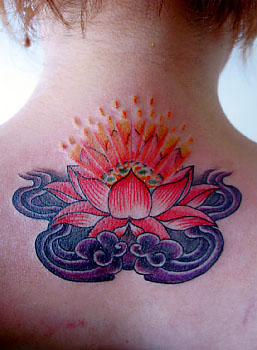
Welcome to the ezine produced by SGI Buddhists that prompts the positive, kindles the constructive, highlights the hopeful and leaves you feeling - well, up!

 Nelumbo nucifera, the lotus flower, has been a sacred symbol for thousands of years, writes Diane Southam
Nelumbo nucifera, the lotus flower, has been a sacred symbol for thousands of years, writes Diane Southam
In the Museum of Egyptian Antiquities in Cairo some years ago I was entranced to see gigantic sculptures of a Pharaoh and his consort, each cradling a lotus in the palm of their hand, smiling peacefully as they gazed into eternity.
Known to the Egyptians as Sesen, the Lotus, according to ancient mythology, had been carved into Upper Egypt in the shape of the Nile and was also a symbol of creation and rebirth. Lotus petals were found scattered over Tutankhamen’s body when his tomb was opened in 1922.
In India the Lotus is credited with having the power to prevent creation. In his book The Lotus Quest leading plant expert Mark Griffiths, who embarked on a remarkable voyage to discover the origins and influence of this sacred species, claims that Lotus seeds have long been used as an oral contraceptive in Udaipur.
For Hindus the Lotus flower symbolises divinity, fertility, wealth and knowledge and is most closely associated with the goddess Maha Lakshmi, who sits on a Lotus flower and is said to bring prosperity, purity and generosity. The god Vishnu, ‘the Lotus-eyed one’ who represents divine beauty and spiritual expansion, also sits on the flower and wears a Lotus-bud crown.
In both Hindu and Buddhist traditions the Lotus is seen as a symbol of spiritual enlightenment because it has roots in earthly mud, but as it grows upwards, towards the light, its petals open out into a pure, radiant flower.
The Lotus is reputed to heal the body as well as the spirit, and both roots and petals are eaten raw in Asia, where it’s also considered to be a culinary delicacy. In Korea the roots are used in vegetable soup and stir-fries.
The seeds themselves have amazing longevity, resilience and transformational potential. A batch of three-thousand-year-old Lotus seeds discovered during an archaeological dig in Tokyo in 1952 was successfully germinated – which perhaps explains why the Lotus became a potent symbol of spiritual rebirth in Buddhism.
In her book 'Life After Death', the groundbreaking Swiss psychiatrist and pioneer of the hospice movement, Elizabeth Kubler-Ross, describes her personal experience of spiritual rebirth following a laboratory-controlled out of body experience:
'…something that looked like a Lotus flower bud appeared and opened into an incredible, beautiful, coloured flower. Behind the Lotus flower appeared the light that my patients so often talk about. As I approached the light through the open Lotus flower, with a whirl in a deep, fast vibration, I gradually and slowly emerged into this incredible, unconditional love, into this light. I became one with it…if we could understand this state of love, then all of us would be whole and healthy.'
Like the Lotus flower, The Lotus Sutra has universal significance. Preached by Shakyamuni Buddha in India around 1000BC, it expounds the universality of Buddhahood, and is to this day recited twice daily, around the globe, by millions of people from a multitude of cultures.

